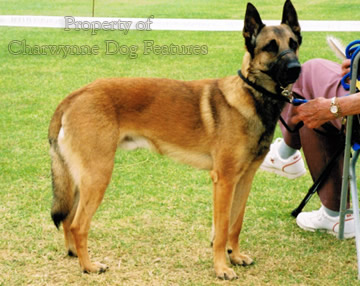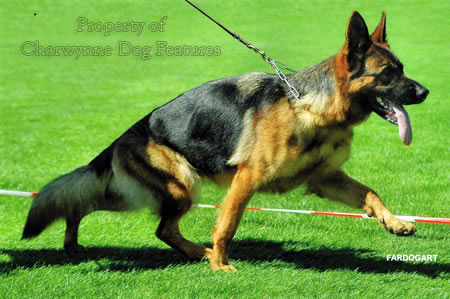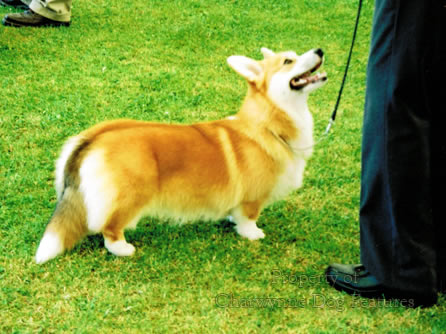463 FALSE VALUES - Misjudging A Pastoral Dog
FALSE VALUES - MISJUDGING THE PASTORAL DOGS
by David Hancock
 Designing a Show Ring Dog - Penalties of Fads and Fancies
Designing a Show Ring Dog - Penalties of Fads and Fancies
Once pastoral and working dogs are away from their place of work, they are vulnerable to those breeders who have no loyalty to their traditional form and functional needs. The wilful neglect to breed for the anatomy essential in such dogs has already been covered. But harm to breeds has been done too by the groundless bias against certain coat colours and the knowing acceptance of coats too long to allow function, sometimes in breach of the breed standard or word picture laid down for that breed. Quite apart from such breaches, restricting a breed’s gene pool by proscribing a colour or by handicapping a dog by breeding for an overlong coat, is unwise, unnecessary and often unkind. There never has been any functional or working justification for such excess but this kind of irrational bias or blind prejudice is hardly new. Such false values can do harm to a breed but more to the members of that breed. How can any fancier justify the movement in a German Shepherd Dog being different from that of a Belgian Shepherd Dog? Why does the former have to ‘gait’ at speed on a harness and have its rear pasterns flat on the ground when standing, when the Belgian dog, with the same fundamental function does not? Designing a pastoral dog purely for the show ring is very unwise.
Danger of Fads
Fads may be passing indulgences for fanciers but they so often do lasting harm to breeds. If they did harm to the breeders who inflict them, rather than to the wretched dogs that suffer them, fads would be more tolerable and certainly more short-lived. But what are the comments of veterinary surgeons who have to treat the ill-effects of misguided fads? In his informative book The Dog: Structure and Movement, of 1970, RH Smythe, a vet and exhibitor, wrote: "...many of the people who keep, breed and exhibit dogs, have little knowledge of their basic anatomy or of the structural features underlying the physical formation insisted upon in the standards laid down for any particular breed. Nor do many of them - and this includes some of the accepted judges - know, when they handle a dog in or outside the show ring, the nature of the structures which give rise to the varying contours of the body, or why certain types of conformation are desirable and others harmful."
Having watched the judging at the 1998 Crufts on Pastoral Group Day, I can see why such words were forthcoming. Having gone to my first dog show over sixty years ago, attended 7 World Dog Shows and innumerable championship shows, I feel, with enormous concern, that things are getting worse rather than better. In his book, Smythe goes on to say that "...the same may sometimes be written regarding those whose duty it is to formulate standards designed to preserve the usefulness or encourage the welfare of the recognised breeds." Encouraging the welfare of the recognised breeds has to be the underlying mission of not just the Kennel Club, whom Smythe is pointedly criticising, but every breeder, every breed club and every judge officiating at dog shows.
Needless Handicaps
"Vex not his ghost: O! let him pass; he hates him
That would upon the rack of this tough world
Stretch him out longer." Shakespeare's King Lear
There is a much-misunderstood expression of desire in the dog show world, the wish to have an exhibit that ‘stands over a lot of ground’. It does not mean, in Shakespeare’s words ‘stretch him out longer’! In every decade, in the world of the pedigree dog, the faddists are at work, sadly in far too many breeds, promoting, for example, the longer loins and hyper-angulated hindquarters, with hind feet positioned well behind the dog, that have strangely become the norm. I see that admirable breed, the Groenendael, short-stepping, with little forward reach, as upright shoulders, aimed at making the exhibit look statuesque in the ring, are favoured. German Shepherd Dogs, in the days when they were still called Alsatians, were famed for their level toplines and their ability to maintain that topline on the move, with a smooth, effortless, gliding locomotion - much envied by other breed fanciers. In more recent times we have 'banana-backed' German Shepherd Dogs valued for their ability to 'gait' at speed whilst apparently lacking the capability of walking soundly. A canny judge will always make his entry walk slowly too around the ring; basic flaws are so often revealed at the slower walk. A pastoral dog is designed to spend most of its working day at a sustained walk not an entirely artificial 'hurry'.
Penalty of Over-exaggeration
In every animal walking on four legs the force derived from pressing the hind foot into the ground has to be transmitted to the pelvis at the acetabulum, and onwards to the spine by way of the sacrum. In over-angulated dogs the locomotive power is directed to an inappropriate part of the acetabulum. In addition, so as to retain the required degree of rigidity of the joint between the tibia and the femur, other muscles have to come into use. In the over-angulated hind limb, the tibia meets the bottom end of the femur at such an angle that direct drive cannot ensue. The femur can only transmit the drive to the acetabulum after the rectus femoris muscle has contracted, enabling the femur to assume a degree of joint rigidity when connecting with the tibia. This means that the femur rotates anticlockwise whereas nature intended it to move clockwise. 
Excessive angulation in the hindquarters, with an elongated tibia, may, to some, give a more pleasing outline to the exhibit when 'stacked' in the ring. But, in the long term, it can only lead to anatomical and locomotive disaster. Such angulation destroys the ability of the dog's forelimbs and hindlimbs to cooperate in harmony in propelling the body. Yet I have heard it argued by breed specialists at seminars that it will increase the power of propulsion operating through the hindlimbs and on through the spine. If it did, the racing Greyhound fraternity would have pursued it with great vigour. I have heard a dog show judge praise an over-angulated dog because it 'stood over a lot of ground'! So does a 'stretched limousine' but it requires a purpose-built construction to permit the luxury.
Inequality between the length of the rear stride and the length of the front stride is producing ugly unsound movement in an ever increasing number of breeds as the contemporary fad for hyper-angulation in the hindquarters gathers more and more momentum. In the Dachshund the hind feet have difficulty keeping tally with the front ones. This, combined with inflexibility in the spine, produces a failure of synchronisation behind. Is this a future worry for Swedish Vallhund and Corgi breeders? In soundly constructed dogs sufficient angulation in the hindquarters and adequate length in the tibia enables the hock to flex and the hind foot to advance beneath the body enough so that balance is maintained. The side effects of excessive angulation in the hindquarters of a number of pedigree breeds are increasingly manifesting themselves. Why then is it becoming almost 'de rigueur' in breeds like the Bouvier, the Old English Sheepdog, the show Border Collie, the Briard and even the Bearded Collie, once such an unspoiled breed?
Uncorrected Flaws
It’s depressing to read show critiques on our native pastoral breeds setting out the same faults year on year. In 2013, in the Bearded Collie classes at two different championship shows, judges reported the high-stepping or Hackney action that ruins the economical movement of any working breed, as well as short legs and long backs. This perpetuates the European ‘look’ in which a longer, lower, dumpier, heavier Beardie is sadly favoured. At the Old English Sheepdog Club show in August 2013, the judge commented on the lack of length of neck, poor layback of shoulder, wide fronts and poor front movement, as well as uncharacteristic heads, with flat skulls, lacking stop, and no definition above the eyes. Time and time again you read of the same recurring flaws in the entry – are the judges wasting their time? Are the Breed Councils noting such perennial faults in breeds they were appointed to care for?
Exaggerated Straightness
In a world where the faddists can hold sway, it is unsurprising that, just as the rear-end exaggerators are harming dogs, so too are those inflicting upright shoulders on an active working breed. The late Tom Horner, an extremely-gifted judge of a dog, who knew a thing or two about movement, has written, in his All About the Bull Terrier of 1973, on this subject: "If the upper arm is short and/or steep, the angle between it and the shoulder blade will be much greater - more open than the desired 90 degrees - with the result that the elbow will be brought forward on the chest and the possible length of stride of the foreleg will be reduced. If shoulders are also steep the angle will be greater still and the stride even shorter." The smaller pastoral breeds with a shortened front stride are now almost the uniform exhibit in our show rings. It is extremely tiresome when this draws admiration from ignorant TV commentators at Crufts, who describe them as "simply flowing over the ground", perhaps because they can't walk naturally! 
In his book About the Border Terrier of 1991, Walter Gardner has written: "The well-laid on shoulder allows for great range and liberty of movement. On the other hand, when the shoulder blade is lacking in correct obliquity and is too upright, it usually lacks the desired length and therefore muscle attachment. The movement is therefore contracted, and the action short, cramped and lacking in elasticity." It is this short, cramped, restricted forward movement that so many of the smaller pastoral breeds demonstrate in the ring - and get rewarded for! Walter Gardner goes on to state: "..it is unfortunate that many of those who are judging dogs have never had the opportunity to judge any other type of stock." Certainly, working horses are often stocky in build but display superbly placed shoulders. This feature is prized in the horse show ring. So many of the pioneer judges at dog shows were pony judges too.
When a dog's shoulders are too upright they tend also to be narrower, shorter and bunch the muscles, giving a coarse look. This in turn shortens the neck and artificially lengthens the back, producing an unbalanced dog. Breeds like the Corgis and the Swedish Vallhund (to a lesser extent) are now longer in the back and certainly shorter in the leg than their ancestors. (I was impressed by the Swedish Vallhund Fennican Elegance under Mystarz at a 2013 show, a puppy with plenty of daylight under it and a more symmetrical torso). Working dogs in the pastoral breeds are usually a little longer backed than their show ring opposite numbers but for a good reason, the long, sloping shoulder tending to accompany the slightly longer back, with the pursuit of a cobby dog, with the shorter back, encouraging the more upright shoulder. Dogs required to herd livestock need flexible backs so that they can work at heel-level. Most of the show Corgis would have some difficulty as agile, working heelers because of the construction now apparently sought in them.
Recognized Problems
The longer back and shorter legs of the Corgi brings its own problems. In their valuable book Medical & Genetic Aspects of Purebred Dogs of 1994, Clark and Stainer write, on Corgis: “Orthopedic problems are occasionally encountered in these chondrodysplastic dogs. Rapidly growing pups will sometimes develop sprain of the shoulder capsule if allowed to descend stairs frequently…The carpus, which are crooked laterally up to 45 degrees, will sometimes cause problems in individuals with excessive deviation. Back problems occur in older dogs, particularly if they are overweight and poorly exercised. Luxated intervertebral lumbar discs and posterior paresis are not uncommon. Neck pain may occur due to calcified cervical discs.” Longer legs, shorter backs and straighter legs alleviate such problems and the early depictions of the Corgi show how exaggeration has remorselessly crept in. Limited forward reach through upright shoulders/short upper arms is reported by judges of this breed, but, sadly in most of the show dogs in the pastoral breeds too; this is not good for any working dog. It is worrying to learn too that the Old English Sheepdog was rated the ninth and the Shetland Sheepdog was ranked the 18th worst mean-scoring breed in the BVA/KC Hip Dysplasia Scheme as of October, 2001. 
I suppose, if a dog can win Best in Show at Crufts with a luxating patella in its right rear leg, it will be argued that anatomical soundness is not a prerequisite for show ring success. Such a worthless victory is more a commentary on judging standards than breed standards. For those who care about dogs and love their breed, physical soundness, the ability of each dog to lead a happy life and the future of the breed thankfully matter more. Freud wrote that dogs love their friends and bite their enemies, quite unlike people, who have to mix love and hate in their object relations. I have quoted Shakespeare's words "...he hates him that would ...stretch him out longer" – but they may need amending in the canine context here. But if exhibitors love winning and hate losing, then seek to please ignorant judges, the effect is the same: their dogs risk being harmed. Exaggeration handicaps the dog; sadly the infection of upright shoulders and excessive angulation has become epidemic in quite a number of breeds – but never in the pastures!
Human Indulgence
When are we going to stop taking advantage of dog's desire to please man and start treating dog as man's respected and valued companion, with needs of their own -- and their pride. Subjecting a dog to hours and hours of washing, drying, combing and brushing is a self-centred human indulgence, never a canine choice. Whenever we indulge ourselves, we need to appreciate that it is a facet of supreme selfishness which calls for honest analysis. Cruelty to animals can be casual, thoughtless and wholly spiritual, as well as violent, nasty and physical.
Indirect cruelty to animals can be quite gentle in application -- by inflicting, for example, such an excessively heavy or long coat on a dog that it is doomed to spending long periods of its life being preened or suffers skin complaints. The owners of long-coated breeds need to pose themselves this question: Is the long coat on my dog a benefit to my dog - or to me Perhaps Lewis Carroll had a message for us in relation to our attitudes to our dogs' coats, when he wrote:
"Their coats were brushed, their faces washed,
Their shoes were clean and neat -
And this was odd, because you know,
They hadn't any feet."